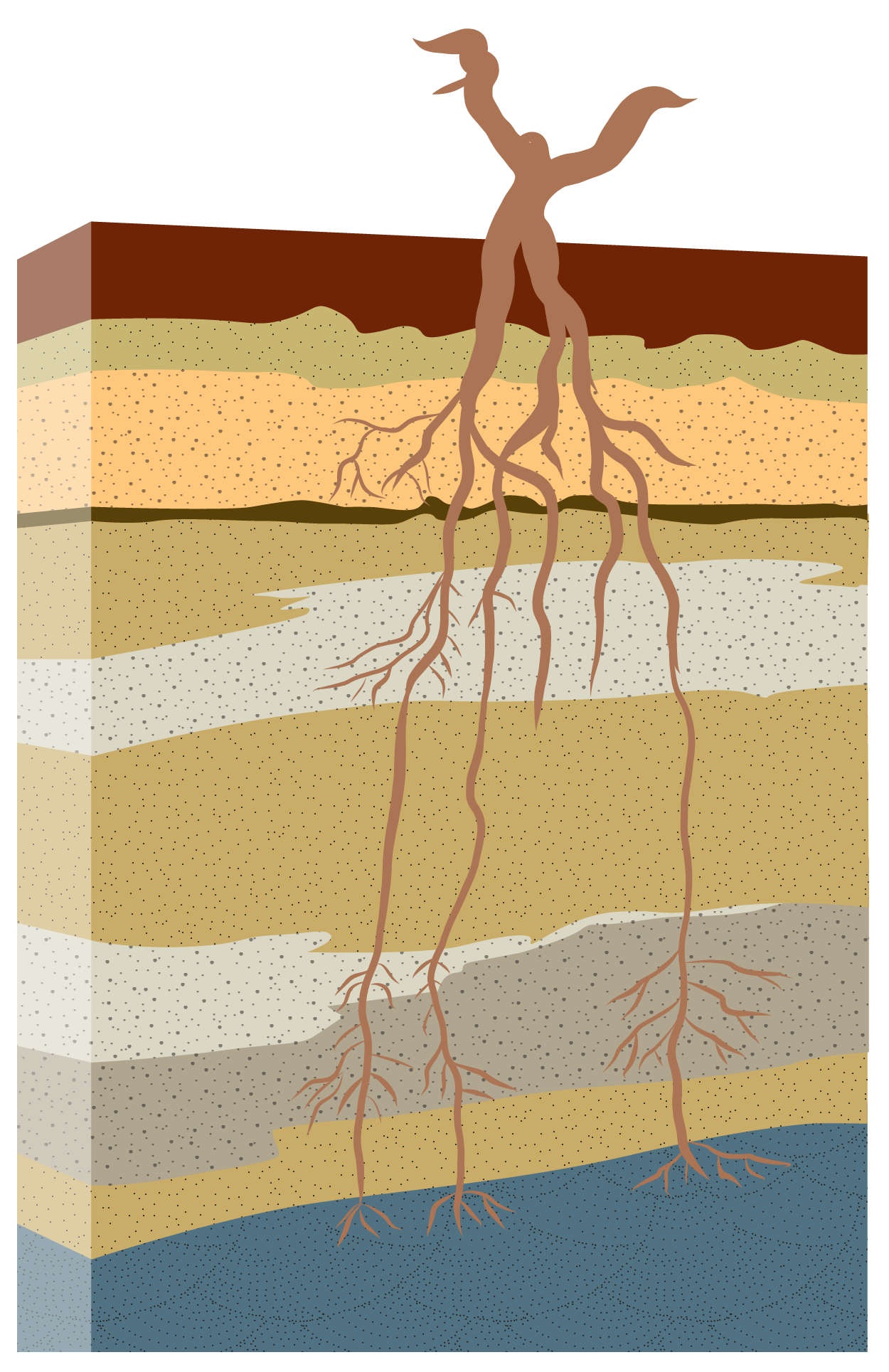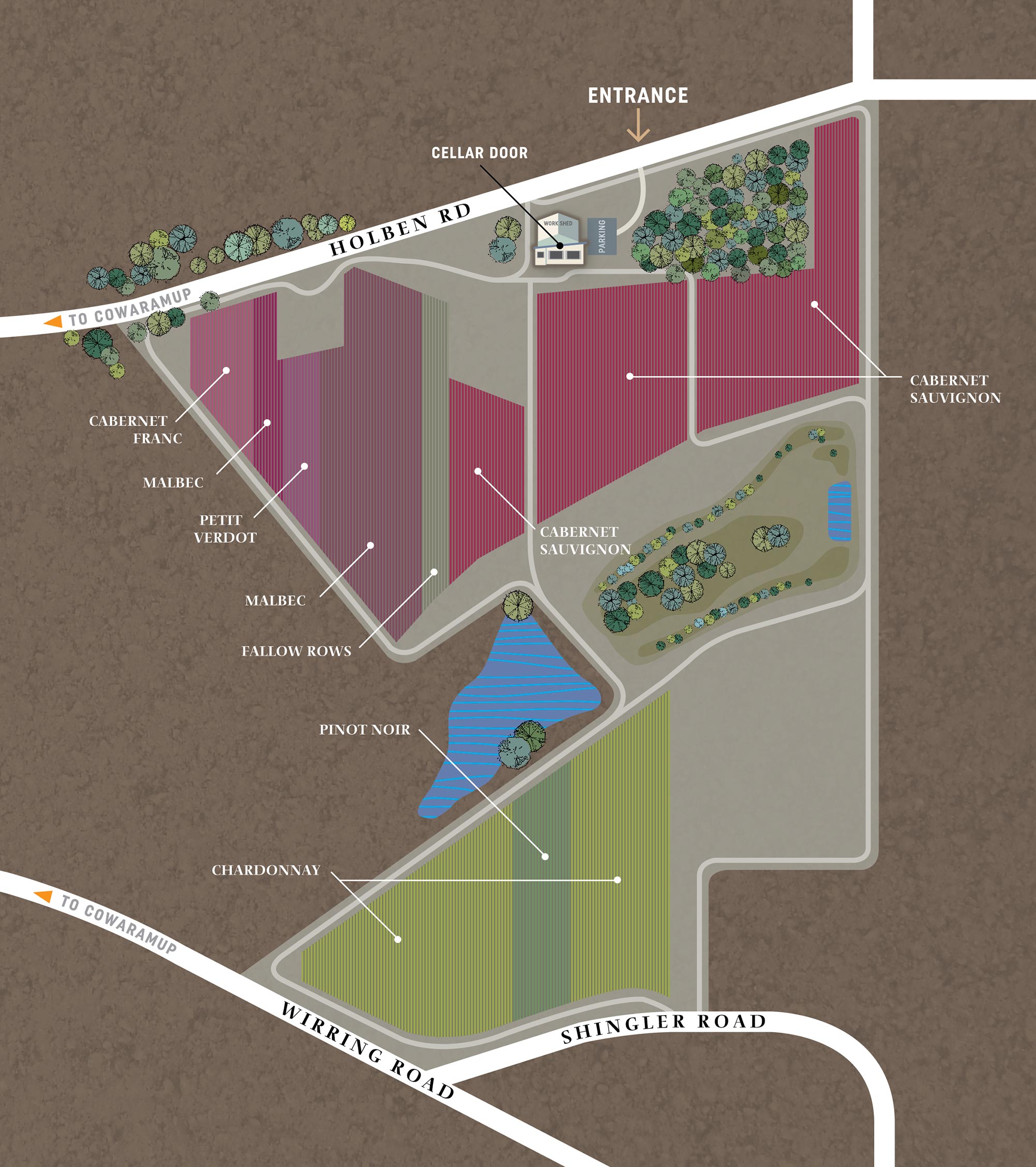Our Philosophy
We aim to create an enduring family business which will override the fashions of the wine markets by making decisions based on the goal of producing the best quality wine from the varieties best suited to our chosen location.
Our goal is that as the family business develops it will enable us to move to the region and become fully involved in its premium wine production.
"...we formulated our plan based on choosing a location with the best soil types together with the appropriate climate"
"...the never irrigated vines...has contributed to the excellent fruit quality that we have obtained."
Our Story
Since the 1980's we have been visiting the Margaret River region frequently. We got to know many people involved in the wine industry in this beautiful region and became infatuated, like so many before us, with the idea of eventually moving to the district, giving up our city jobs and making a living from wine production. Trips to France and California further convinced us that the Margaret River region was special and that this was the place to try to make a go of it.
We decided that if we were going to be involved in the industry, we needed to make our own wine and to lessen the risks involved in that venture, it was critical that we made the best wine that we were able to. We knew that we didn't have the financial resources to compete in the mid range bracket of the market.
For personal satisfaction and for the possibility of eventually making the whole idea work, we decided, after consultation with a number of people, that we needed to focus on the absolute premium end of the market.
As James Halliday said then, and as is now well recognised, the varieties that thrive in Margaret River are the Bordeaux reds, being Cabernet Sauvignon, Merlot, Cabernet Franc, Malbec and Petit Verdot, and the various Chardonnay clones. Whilst there are a few notable exceptions to this, it seemed to us, that these were the varieties that had given Margaret River status, well beyond its size, on the world stage.
By this stage, we had become good friends with Keith and Clare Mugford, the proprietors of Moss Wood, which was clearly at the very top of the premium end of the market. After many discussions with Keith and Clare, and others, we formulated our plan based on choosing a location with the best soil types together with the appropriate climate for the planting of the Bordeaux cabernet varieties and chardonnay vines.
In 1997 we purchased a property on the slopes of the Wirring Valley, approximately 5 kilometres south of the Cowaramup township in the Margaret River region. This valley contained the gravelly soil structure we had been looking for and Keith was of the view, that the climate should be ideal for the ripening of the Bordeaux and Chardonnay varieties.
The 31 hectare (77 acres) property had been substantially cleared for dairy farming, but had retained some magnificent stands of Jarrah and Marri. The property had both sides of a gently sloping valley and a permanent spring fed creek running through the middle.
At this time, we were settling our strategic plans and Keith agreed that Moss Wood would formally consult on the project, their involvement being right through from soil preparation to wine making. We were of course thrilled with this development, but were then faced with our most difficult decision.
The greatest wines of Margaret River, in our opinion being the Moss Wood and Cullen reds and the Leeuwin Estate Chardonnay, all come from never irrigated vineyards. The theory being, as many will know, that roots forced to go deep to find the water table will pass through a more complex array of mineral and vegetative matter and thus obtain a more complex combination of flavours. In addition, at vintage, the non irrigated vines, being stressed by the lack of water, will pour their energy into their fruit rather than into the leaf and vine structure.
However, not irrigating in our climate is fraught with risk and when we eventually decided to take that course, Keith described our decision as "courageous".
Luck was with us at that stage and ground preparations having been completed, in 1998 we planted, by hand, 10,000 Cabernet Sauvignon, Cabernet Franc, Malbec and Petit Verdot cuttings, in the driving rain. The Cabernet Sauvignon, Franc and Petit Verdot cuttings came from Moss Wood, and the Malbec from Alkoomi.
As a result, the vines have struggled and have had to send their roots deep to survive. This resulted in certain unevenness in the vineyard but, we believe it has contributed to the excellent fruit quality that we have obtained.
Having committed to the courageous philosophy of no irrigation, we have also closely tried to emulate the Moss Wood model of extremely diligent vineyard management including hand pruning to ensure low yields, leaf plucking, shoot thinning and careful canopy management generally, minimal use of chemicals and hand picking to ensure that the fruit arrives at the winery in the best possible condition.
Two hectares of chardonnay vines were planted in 2001, and have produced their first crop in 2005. We have planted a combination of the traditional mendoza (Gingin) clone together with the clones chosen from the Burgundian trials of the 1980s.
Our Name - Victory Point
The name Victory Point is derived from the almost forgotten site located at the end of our road.
Local historians have told us, it was seconded and named by the district's pioneers, either because of the famous victories that occurred on the cricket pitch that is still there, or more likely, because the area was used to train the local lads prior to their departure for WWII. Community celebrations were held here, including the announcement of Peace at the end of the war.
We chose the name Victory Point to represent the celebratory and community spirit of country Australia.
The Vineyard
The property is located approximately 5 kilometres from the township of Cowaramup, in the Margaret River wine growing region of Western Australia.
The vineyard is made up of two broad slopes of the valley, divided by a permanent creek line.
Cabernet Sauvignon
The northern and most gravelly slope is planted with the varieties for the production of the traditional Bordeaux blend of wine.
These are:
Cabernet sauvignon 6.5 hectares
Cabernet franc 0.5 hectares
Malbec 1.5 hectares
Petit verdot 0.7 hectares
Chardonnay
Part of the southern slope is planted with 4.2 hectares of chardonnay. These vines were planted from 2000 and have been allowed to develop their root structures to prepare for the first crop in 2005.
In planting the chardonnay vineyard we have gained from the research of Bill Pannell, owner of Picardy vineyard in Pemberton, WA.
Bill was involved in Burgundy during the 1980's when extensive trialling of the best quality chardonnay and pinot noir clones was undertaken. Bill was the first to introduce the selected clones to Australia.
The vineyard is planted with the traditional mendoza clone together with the burgundian clones; 277,96,95 & 76.
Premium quality management
Premium quality management underpins all our winemaking activities at Victory Point Wines. Please read more about our process and attention to detail enabling us to bring consistant premium quality wines to your table.
Soil Structure
The dominant soils of the Victory Point vineyard are the Forest Grove gravelly and sandy loams over a clay sub-soil. This structure is known for its high potential for viticulture.
We have undertaken several projects to preserve and restore the natural structure of the soil.
More than 5000 trees, native to the district, have been planted to re-establish the wetland area around the creek and prevent soil erosion.
Different cover crops are selected each year and mulched to the soil in the summer. This provides natural chemical replacement, and stabilises the top soils and prevents weed growth in winter.
The use of our "in-line" weed digger has been extremely successful in controlling other weeds and allows us to manage the vineyard without the use of herbicides.
Never Irrigated
The decision to not irrigate the vineyard was made at the initial planning stage in an effort to maximise the complexity of flavours from the fruit and the individual characteristics of the vineyard at each vintage.
The theory being, that roots forced to go deep to find the water table will pass through a more complex array of mineral and vegetative matter and thus obtain a more complex combination of flavours.
The subtleties and variation of each vintage are truly reflected in wines produced from unirrigated vines.
Annual Vine Management
The experience of our consultant, Keith Mugford from Moss Wood, was extremely beneficial in determining the vine trellising system.
After more than 20 years in the vineyards of Margaret River, Keith was in no doubt about the impact of the appropriate type of trellising for each site. The VSP system was employed at Victory Point and has proven to give the fruit maximum exposure to the sunlight, which has ensured full ripening at vintage.
Over the growing season, the new shoots are all hand trained along the growth wires of the trellising system. As the leaf canopy becomes denser, it is vertically lifted, by positioning wires. This leaves the fruit bunches exposed to the sunlight, and minimises the risk of disease.
Constant checking of the vines will determine how much further leaf plucking is required if the growth is considered too rigorous.
At veraison crop thinning is carried out by hand to ensure each vine is producing at the optimal rate.
As each variety reaches its pre-determined ripeness level, the grapes are hand picked and delivered to the winery.
The vineyard can now retire for the winter, and quickly the signs of the stressful summers growing activities are reflected in the changing colour of the leaves as the vines move toward dormancy.
As June approaches the Victory Point team prepare for the all important task of hand pruning each vine, which will determine the yield potential and shoot positioning for growth over the coming year.



